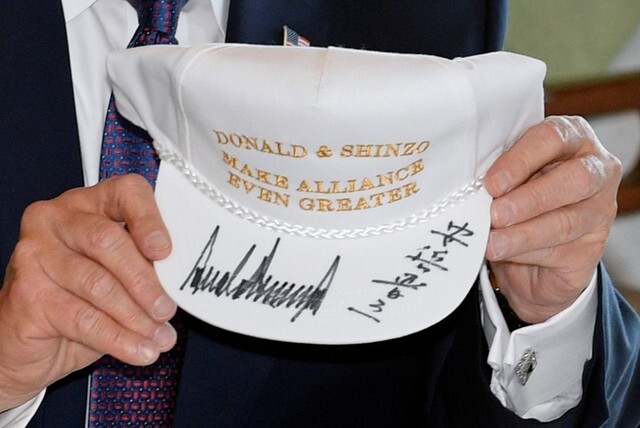hankyoreh
Links to other country sites 다른 나라 사이트 링크
[Editorial] Trump’s Japan visit offers a preview of his probable demands to South Korea

There was something odd about US President Donald Trump’s behavior during his visit to Japan. He has displayed a strong rapport with Japanese Prime Minister Shinzo Abe on previous occasions, and on this trip the two leaders were chummy once again as they went for a round of golf and shared no fewer than four meals over the course of two days. Trump also took the time to meet Japanese whose family members had been kidnapped by North Korea.
After Abe’s party won a recent snap election by a landslide in part due to fears about North Korea, Trump effectively helped Abe further strengthen his position in domestic politics.
But during a meeting with businesspeople from the US and Japan on Nov. 6, Trump singled out the automotive industry to voice his grievances. “Our trade with Japan is not fair and it's not open,” he said. “The United States has suffered massive trade deficits with Japan for many, many years.” Trump went on to emphasize that “we've started the process” to rectify unfair trade.
Trump made a point of bringing this issue up once again during a joint press conference for the summit, noting that the US would be working to resolve unfair trade relations. Trump also spoke effusively about Japan purchasing a large amount of US-made weapons. Trump’s negotiating techniques as a businessman were on full display – flattering his counterpart by emphasizing the alliance before zeroing in on the goal.
Given Trump’s behavior during his visit to Japan, it is easy to predict what demands he will make during his summit with South Korean President Moon Jae-in on Nov. 7. Now that South Korea has consented to American demands to renegotiate the two countries’ free trade agreement, trade pressure on South Korea and demands for it to purchase US-made weapons are likely to grow even stronger. Trump bluntly said that the countries of northeast Asia should purchase even more American weapons, noting that Japan ought to be ordering weaponry given “what's happening with one of your neighbors,” referring to North Korea.
The US has deployed its THAAD missile defense system in Seongju, North Gyeongsang Province, and it has also decided to upgrade the deployment status of strategic assets such as the USS Ronald Reagan nuclear-powered aircraft carrier, B-1B strategic bombers and F-35B stealth fighters to “permanent deployment” on the Korean Peninsula. The cost of this will be substantial, and Trump is likely to ask South Korea to provide some economic compensation. The defense-sharing negotiations are coming up next year. US demands for weapons deals could become more overt.
South Korea needs to treat Trump’s visit as an opportunity to reinforce its alliance with the US and to concentrate on working together to find a peaceful solution to the Korean Peninsula issue. It also needs to keep its priority on the national interest as it responds to Trump’s attacks on trade and demands for increased weapons purchases
Please direct questions or comments to [english@hani.co.kr]

Editorial・opinion
![[Column] Season 2 of special prosecutor probe may be coming to Korea soon [Column] Season 2 of special prosecutor probe may be coming to Korea soon](https://flexible.img.hani.co.kr/flexible/normal/500/300/imgdb/original/2024/0426/3317141030699447.jpg) [Column] Season 2 of special prosecutor probe may be coming to Korea soon
[Column] Season 2 of special prosecutor probe may be coming to Korea soon![[Column] Park Geun-hye déjà vu in Yoon Suk-yeol [Column] Park Geun-hye déjà vu in Yoon Suk-yeol](https://flexible.img.hani.co.kr/flexible/normal/500/300/imgdb/original/2024/0424/651713945113788.jpg) [Column] Park Geun-hye déjà vu in Yoon Suk-yeol
[Column] Park Geun-hye déjà vu in Yoon Suk-yeol- [Editorial] New weight of N. Korea’s nuclear threats makes dialogue all the more urgent
- [Guest essay] The real reason Korea’s new right wants to dub Rhee a founding father
- [Column] ‘Choson’: Is it time we start referring to N. Korea in its own terms?
- [Editorial] Japan’s rewriting of history with Korea has gone too far
- [Column] The president’s questionable capacity for dialogue
- [Column] Are chaebol firms just pizza pies for families to divvy up as they please?
- [Column] Has Korea, too, crossed the Rubicon on China?
- [Correspondent’s column] In Japan’s alliance with US, echoes of its past alliances with UK
Most viewed articles
- 1[Column] Season 2 of special prosecutor probe may be coming to Korea soon
- 2‘We must say no’: Seoul defense chief on Korean, USFK involvement in hypothetical Taiwan crisis
- 3N. Korean delegation’s trip to Iran shows how Pyongyang is leveraging ties with Moscow
- 4Amnesty notes ‘erosion’ of freedom of expression in Korea in annual human rights report
- 5[Editorial] Korea’s surprise Q1 growth requires objective assessment, not blind fanfare
- 6Division commander ordered troops to enter raging flood waters before Marine died, survivor says
- 7[Reportage] On US campuses, student risk arrest as they call for divestment from Israel
- 8Korea sees more deaths than births for 52nd consecutive month in February
- 9Is N. Korea threatening to test nukes in response to possible new US-led sanctions body?
- 10Is Japan about to snatch control of Line messenger from Korea’s Naver?